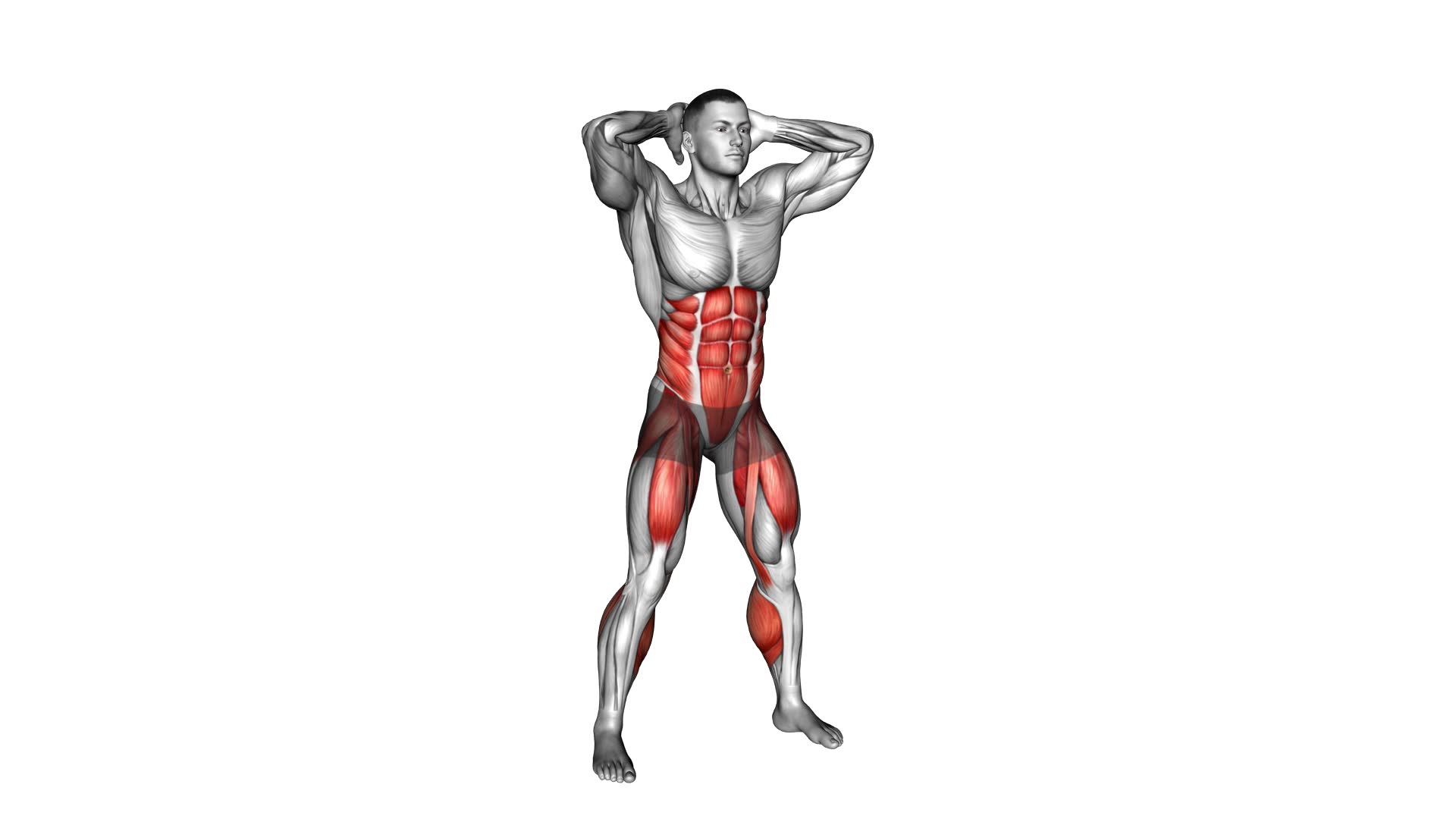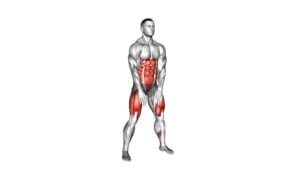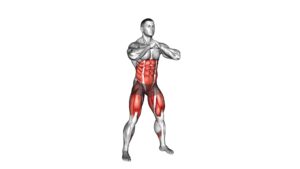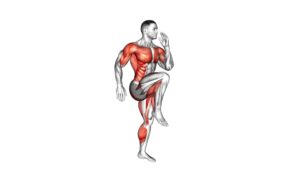High Knee Squat (male) – Video Exercise Guide & Tips

Are you looking to strengthen your lower body and improve your overall fitness? Then the High Knee Squat is the exercise for you.
Watch This Exercise Video
In this video exercise guide, we will show you the proper form and technique for performing this exercise. You'll also learn various variations and progressions to keep challenging yourself.
Avoid common mistakes and maximize your results with our helpful tips.
Get ready to take your fitness to new heights with the High Knee Squat.
Key Takeaways
- High knee squats strengthen the lower body and improve overall balance and stability.
- They are effective for injury prevention and engage multiple muscle groups in the lower body.
- High knee squats enhance overall athletic performance and increase lower body strength.
- They also burn calories effectively and enhance cardiovascular fitness.
Benefits of High Knee Squat
You can maximize your workout by incorporating high knee squats, which help strengthen your lower body and improve overall balance and stability. High knee squats are an effective exercise for injury prevention and muscle activation.
When performing high knee squats, you engage multiple muscle groups in your lower body, including your quadriceps, hamstrings, glutes, and calves. This not only helps to build strength and tone in these areas but also enhances your overall athletic performance.
One of the key benefits of high knee squats is injury prevention. By strengthening the muscles around your knees, you can reduce the risk of common knee injuries, such as ACL tears or meniscus tears. Additionally, high knee squats help to improve your balance and stability. This is crucial for maintaining proper form during other exercises and daily activities, reducing the risk of falls or other accidents.
To get the most out of your high knee squats, it's important to maintain proper form and technique. This will ensure that you're targeting the correct muscles and minimizing the risk of injury.
Proper Form and Technique
Achieving proper form and technique is essential for maximizing the benefits of high knee squats. To ensure that you perform the exercise correctly and avoid potential injuries, follow these injury prevention techniques and proper warm-up exercises:
- Injury Prevention Techniques
- Maintain proper alignment: Stand with your feet shoulder-width apart and your toes pointing slightly outward. Keep your chest lifted and your core engaged throughout the movement.
- Control your descent: As you squat down, focus on controlling the movement and avoiding any sudden drops or jerky motions. This will help protect your knees and prevent strain on your muscles.
- Proper Warm-Up Exercises
- Hip circles: Stand with your feet shoulder-width apart and place your hands on your hips. Slowly rotate your hips in a circular motion, first clockwise and then counterclockwise. This will help warm up your hip joints and increase their mobility.
- Dynamic stretches: Perform exercises such as leg swings and walking lunges to warm up your leg muscles and improve flexibility.
Variations and Progressions
To explore different ways to challenge yourself and progress with high knee squats, try incorporating variations into your routine. These advanced modifications can help increase muscle activation and take your workout to the next level.
One variation you can try is the high knee squat jump. Start by performing a regular high knee squat, but instead of returning to the starting position, explosively jump up in the air, driving your knees towards your chest. Land softly and immediately go into the next rep. This variation adds a plyometric element to the exercise, increasing the intensity and targeting your leg muscles even more.
Another variation is the weighted high knee squat. Hold a dumbbell or kettlebell in each hand at shoulder height while performing the high knee squat. The added weight will challenge your muscles and increase the resistance, helping to build strength and endurance.
You can also try incorporating balance challenges into your high knee squats. Stand on a stability ball or a BOSU ball while performing the exercise. This will engage your core muscles and improve your balance and stability.
Remember to always maintain proper form and technique while performing these variations. Start with lighter weights and gradually increase the difficulty as you become more comfortable and stronger. Have fun experimenting with these variations and watch as your high knee squats become even more effective in targeting and activating your muscles.
Common Mistakes to Avoid
To ensure proper form and maximize the effectiveness of your high knee squats, it's important to be mindful of common mistakes that can hinder your progress. By avoiding these errors, you can prevent injuries and make modifications for beginners as needed.
Here are some common mistakes to watch out for:
- Rounding your back: Keep your back straight throughout the exercise to prevent strain on your spine and lower back. Engage your core muscles to maintain stability.
- Leaning too far forward: It's essential to maintain an upright posture during high knee squats. Leaning too far forward puts excessive pressure on your knees, increasing the risk of injury. Keep your chest up and imagine a straight line from your head to your heels.
- Lifting your heels: As you lower into the squat position, make sure to keep your heels firmly planted on the ground. Lifting your heels can lead to instability and place unnecessary stress on your knees.
- Not going low enough: Aim to squat down until your thighs are parallel to the ground or even lower if you can. Failing to go low enough reduces the effectiveness of the exercise and limits the engagement of your leg muscles.
Tips for Maximizing Results
To maximize your results, incorporate these key strategies into your high knee squat routine.
First, consider modifying the high knee squat to fit your fitness level and goals. If you're a beginner, start by performing the exercise without weights or with lighter dumbbells. As you become more comfortable and stronger, gradually increase the weight to challenge your muscles. On the other hand, if you're an advanced lifter, you can incorporate more challenging variations such as weighted high knee squats or plyometric high knee squats.
In addition to modifying the exercise, it's important to incorporate high knee squats into your workout routine effectively. One way to do this is by including them as part of a lower body or full body workout. You can perform high knee squats alongside other compound exercises like lunges, deadlifts, or step-ups to target multiple muscle groups at once.
Another strategy is to incorporate high knee squats into a circuit training routine, where you perform a series of exercises with minimal rest in between. This can help increase the intensity of your workouts and promote cardiovascular fitness.
Remember to focus on proper form and technique throughout your high knee squat routine. Engage your core, keep your back straight, and push through your heels as you perform the exercise. By following these tips and incorporating high knee squats effectively into your workout routine, you can maximize your results and achieve your fitness goals.
Frequently Asked Questions
How Many Calories Can Be Burned by Performing High Knee Squats?
Performing high knee squats can help you burn calories and reap several benefits.
This exercise is a great way to engage multiple muscles in your lower body, including your quadriceps, hamstrings, and glutes. By incorporating high knee movements, you increase the intensity and elevate your heart rate, leading to calorie burning.
Additionally, high knee squats can improve your balance, stability, and overall lower body strength.
Can High Knee Squats Help Improve Balance and Coordination?
High knee squats offer a variety of benefits, including improved balance and coordination. By engaging multiple muscle groups and challenging your stability, these exercises can help you enhance your overall coordination skills.
Additionally, high knee squats can be performed in different variations, such as adding weights or incorporating jumps, which can further enhance your balance and coordination abilities.
Incorporating high knee squats into your workout routine can be a great way to improve these important fitness components.
Are High Knee Squats Suitable for Individuals With Knee or Hip Problems?
High knee squats may not be suitable for individuals with knee or hip problems. These exercises put a lot of stress on the joints, which can worsen existing issues.
However, there are modifications you can make to reduce the impact on your knees and hips. For example, you can perform low impact exercises like seated leg lifts or modified lunges.
It's important to consult with a healthcare professional or a fitness trainer to find alternative exercises that are safe for your specific condition.
How Many Sets and Repetitions Should Be Performed for Optimal Results?
To achieve optimal results with high knee squats, it's important to focus on both sets and repetitions.
The number of sets you should perform depends on your fitness level and goals. For muscle growth, it's recommended to do 3-4 sets of high knee squats.
As for repetitions, aim for 8-12 per set. This will challenge your muscles and promote muscle growth.
Remember to listen to your body and adjust the intensity as needed.
Can High Knee Squats Be Incorporated Into a Full-Body Workout Routine?
Incorporating high knee squats into a full-body workout routine can provide a challenging and effective exercise. By adding this move to your routine, you'll be targeting multiple muscle groups, including your quadriceps, hamstrings, glutes, and core.
This exercise also helps improve balance and coordination. To maximize the benefits, perform high knee squats with proper form and gradually increase the intensity. Remember to consult with a fitness professional if you have any concerns or questions.
Conclusion
In conclusion, the high knee squat is a beneficial exercise that targets the lower body muscles, particularly the quadriceps and glutes. By maintaining proper form and technique, you can maximize the effectiveness of this exercise.
Additionally, incorporating variations and progressions can help challenge your muscles and prevent plateaus. Avoiding common mistakes and following the tips provided will ensure you achieve optimal results from the high knee squat.
So, start incorporating this exercise into your workout routine and reap its many benefits.

Author
Years ago, the spark of my life’s passion ignited in my mind the moment I stepped into the local gym for the first time. The inaugural bead of perspiration, the initial endeavor, the very first surge of endorphins, and a sense of pride that washed over me post-workout marked the beginning of my deep-seated interest in strength sports, fitness, and sports nutrition. This very curiosity blossomed rapidly into a profound fascination, propelling me to earn a Master’s degree in Physical Education from the Academy of Physical Education in Krakow, followed by a Sports Manager diploma from the Jagiellonian University. My journey of growth led me to gain more specialized qualifications, such as being a certified personal trainer with a focus on sports dietetics, a lifeguard, and an instructor for wellness and corrective gymnastics. Theoretical knowledge paired seamlessly with practical experience, reinforcing my belief that the transformation of individuals under my guidance was also a reflection of my personal growth. This belief holds true even today. Each day, I strive to push the boundaries and explore new realms. These realms gently elevate me to greater heights. The unique combination of passion for my field and the continuous quest for growth fuels my drive to break new ground.







